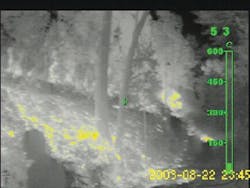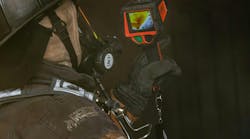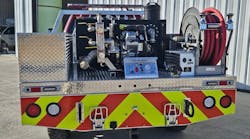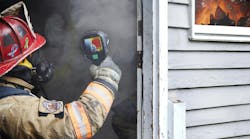At least once each year, I try to write a column about wildland firefighting and thermal imaging. Although I typically like to poke fun at the level of crazy it requires to do the job of a wildland firefighter, the truth is that these guys and gals get nothing but the utmost respect from me. I have never lived in an area where my property would be at risk from the devastation of a wildland fire, but I have had the opportunity to work with, train with and observe the elite crews that are given the responsibility of being on the front line when these events occur. I have the deepest respect for these firefighters. The levels of physical fitness, mental determination, camaraderie, training and preparedness are unparalleled.
With a heavy heart, I offer an updated version of one of my previous columns as a tribute to the 19 firefighters who recently gave their lives. Although there are many uses for thermal imaging at wildland fires, I want to be clear that I am, in no way, indicating that thermal imaging would have made a difference in the outcome of the tragedy in Arizona. This is why I chose a previous column. Where I have included new information, it is indicated by italics. I pray for healing for the families of these fallen heroes and also pray for the firefighters we lost. Rest well, my brothers.
With training, many years of practice and maybe just a little bit of crazy, generations of wildland firefighters have approached fires that are measured in acres or thousands of acres and thought, “Yep, I can do that!” They have battled fires from the air and on the ground, often in poor visibility and with limited support. If things go wrong, “safety” is much farther away than the front porch. If things go very wrong, “safety” may get no better than a small piece of tin foil referred to as a fire shelter. The facts coming to light after the Yarnell, AZ, fire indicate that these shelters are a “last resort” and not infallible. Now, with the emergence of thermal imaging in several wildland firefighting applications, working conditions on the ground and information gathering from the air can be greatly enhanced.
Used properly, thermal imagers can help crews more effectively monitor fire conditions, place personnel in key areas to create control lines, enhance safety during firefighting and improve the control of prescribed burns. Firefighters can also use thermal imagers to enhance their safety when navigating through smoke and maintain accountability even when separated by distance and poor visibility. The advent of smaller thermal imagers, longer operating times and alkaline battery packs have made the technology more deployable and more applicable to the job of the wildland firefighter.
Common applications
Although the potential uses for a thermal imager are limited only by the imagination of the firefighter, we will focus on the areas that see the most common use.
• Monitoring the flank and head of the fire from the air. With a thermal imager, the fire’s location and progress will be evident from an aerial position, regardless of daylight or smoke conditions. This enables precise monitoring of fire progress that would not otherwise be possible. By aerial, I am referring to aircraft. We know from the reports that the Yarnell crew had a spotter (the only surviving member), but terrain often makes monitoring from the ground difficult. Accurately sizing-up a fire lets the incident commander properly deploy available resources and make more effective stops on otherwise growing fires.
Many times, the flank or head of the fire is obscured in heavy smoke, particularly in wet areas or in the presence of green fuels. With a thermal imager, accurate assessment of the fire and spread can be obtained regardless of smoke conditions. The ability to monitor fire progress during low-light conditions means that crews can begin operations earlier in the day and end later in the evening, thereby increasing efficiency.
• Placing and monitoring personnel. Especially in large operations, the placement of limited personnel is critical to gaining control. With the enhanced visibility that thermal imaging provides, wildland firefighters can be placed in key locations where control lines must be constructed. Proper placement enhances the ability of firefighters to protect exposures, including structures, threatened habitats and critical infrastructure. As ground crews deploy, airborne supervisors can monitor their locations and ensure a coordinated and effective response.
Both ground and air crews can effectively deploy thermal imagers. Equipping ground crews with thermal imagers can give them the ability to monitor fire conditions in their immediate area providing more localized advanced warning than might otherwise be possible. A thermal imager can often give an impression of how much relative heat is being carried in the smoke. While not definitive, it is one more tool in the toolbox.
• Monitoring dangers and extinguishing hot spots on the ground. With proper training on image interpretation, firefighters can use thermal imagers to monitor fire movement on the ground and in the trees above them. The direction and volume of fire bands can be tracked and monitored with a thermal imager. With practice, firefighters can identify snags, thereby improving safety on the job. During mop-up, crews with thermal imagers can scan burned areas to ensure that the fire is out and better prevent the opportunity for flare-up or rekindle.
• Managing prescribed burns. Controlled burns are critical toward reducing the fuel load to improve manageability of wildland fires when they inevitably occur. Using the image on a thermal imager, wildland firefighters involved in prescribed burning can monitor the direction of fire spread and manage mop-up more effectively. This provides information that enables them to protect exposures and keep these burns in a controlled state.
• Navigation. When firefighters travel by ground during active wildland fires, their vision may be obscured by smoke. Thermal imagers used from a vehicle can assist the driver in navigating safely through thick smoke, avoiding fixed hazards as well as firefighters on foot. Firefighters on foot can use a thermal imager to help identify safer travel routes based on terrain or fire movement. This can help crews move safely and effectively when smoke obscures their vision. Thermal imagers also provide an effective means of night vision. Since a thermal imager does not register light, its picture is fairly consistent, regardless of daylight conditions. This can extend firefighting operations and enhance crew safety by providing clear views of surrounding terrain and potential escape routes.
Sometimes, a thermal imager can give you information that will help you to make the “best bad decision” you can make. If you are in the position of having to deploy fire shelters for protection, there are likely no “good decisions” left. In this case, a thermal imager may be helpful in picking the best spot based on a quick scan of the area. Even though the best spot may be chosen, this by no means guarantees safety.
Never forget the basics
Firefighters should be aware that thermal imaging technology is not a replacement for basic tactics. There may be times in mop-up when a thermal imager cannot detect a hidden heat source, such as when the heat exists deep within a tree trunk. There may also be times when the image on a thermal imager appears inconclusive to the user. When a thermal imager is not providing as much information as desired, firefighters should rely on traditional techniques.
As with any other application of thermal imaging, planning and practice are the keys to effective technology usage. Firefighters must not only understand what they are seeing on a thermal imager, but they must also learn how to use this information seamlessly with the topographical and locational information they already employ on the job.
Most thermal imagers on the market today were designed to operate inside a structure. These imagers are equipped with a wide field of view so that a structural firefighter entering a room can see much of the room in one quick glance. While this is a benefit to the structural firefighter, it can serve as a detriment to the wildland firefighter.
The side effect of a wide field of view is a limitation of distance. All thermal imagers have a detection range. This typically defines a size of a heat target – three feet by three feet, for example – and a distance at which the target can be detected. While there are numerous variables to account for, you should understand that the farther away you are, the more likely it is that something can be missed by a thermal imager. This is not to say that you need to be within a certain distance (handheld thermal imagers are commonly used from the air); rather, you should simply practice with it and get a feel for what the technology is telling you.
Conclusion
Thermal imagers can be used to improve operations in a wide variety of wildland firefighting operations from the air and on the ground. While the dangers faced by wildland firefighters are different from those faced by structural firefighters, the thermal imager is a tool that can benefit firefighters in both types of incidents. By first understanding how a thermal imager can be employed during a wildfire response and then practicing with it on a regular basis, firefighters can improve their personal safety as well as team effectiveness. Remember, the 10 “Standard Firefighting Orders” and “18 Watchout Situations” (http://www.fs.fed.us/fire/safety/10_18/10_18.html) are the bible of wildland firefighting and thermal imagers should only be used to enhance the decision-making process.
My sincerest condolences to everyone impacted by this tragic loss. Nineteen is a difficult number to wrap your mind around. In an effort to give myself some perspective, I created a list of 19 close friends and then tried to imagine them all gone. The pain is unimaginable.






